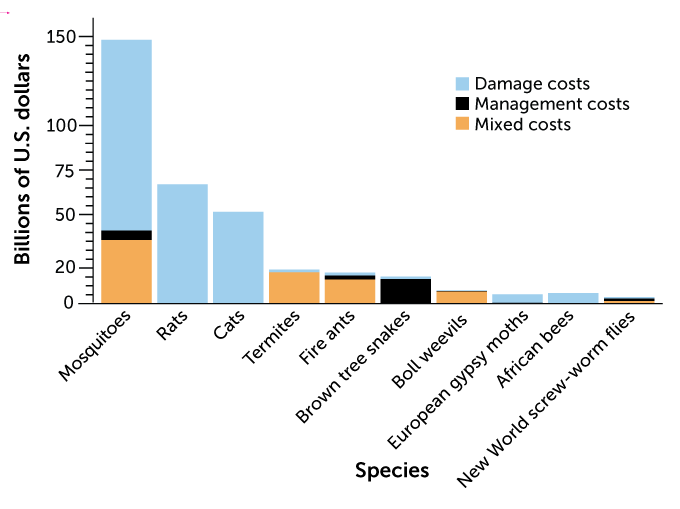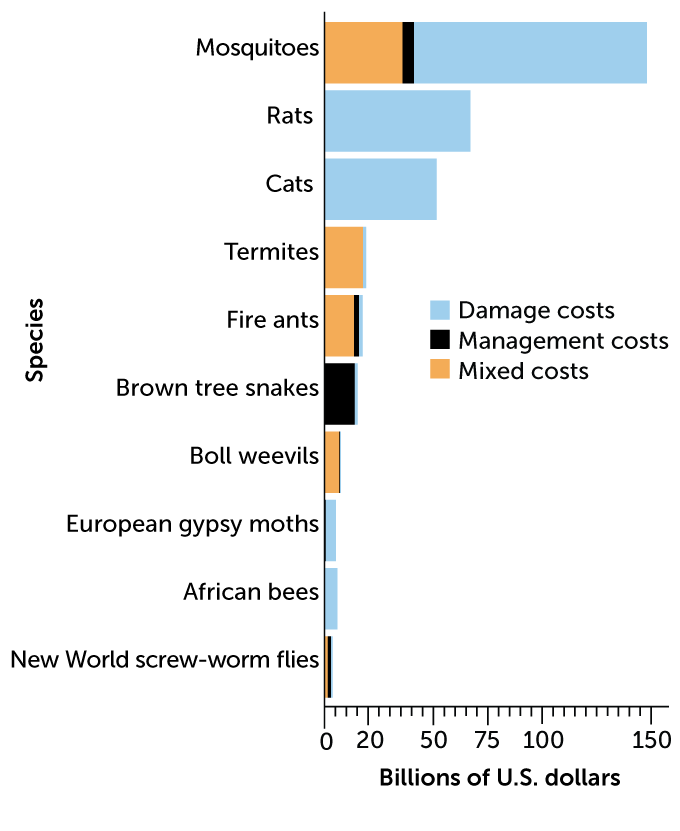Invasive species can wreak havoc on local ecosystems. Cleaning up that biological wreckage comes at a big price.
These invaders, often thrust into new environments unintentionally (or intentionally, to combat pests) by humans, can transmit new diseases, devastate crops and eat away at crucial infrastructure. From 1970 to 2017, such invasions cost the global economy at least $1.28 trillion in damages and in efforts to control them, researchers report March 31 in Nature. As the globe becomes increasingly interconnected and invasive species take over new habitats, that cost grows.
“For decades, researchers have been evaluating the significant impacts of invasive species, but the problem isn’t well known by the public and policy makers,” says Boris Leroy, a biogeographer at the French National Museum of Natural History in Paris. “By estimating the global cost, we hoped to raise awareness of the issue and identify the most costly species.”
Leroy and his colleagues screened over 19,000 published papers, ultimately analyzing nearly 1,900 that detailed the costs of various invasions at particular times. The team then constructed a statistical model that estimated yearly costs, adjusting for factors like inflation, different currencies and timescales. Between 1970 and 2017, annual costs roughly doubled every six years, reaching a yearly bill of $162.7 billion in 2017.
Costly critters
Some invasive species cause more economic damage than others. Researchers analyzed published data from the past few decades to rank the 10 costliest species or species groups from 1970 to 2017. Total costs are broken down into damages, costs of managing invasive species, and costs that don’t fit neatly into one of those categories. Most of the top offenders are insects — mosquitoes head the list while screw-worm flies round it out — but cats, rats and some snakes are big troublemakers, too. Gaps in data — on plants, for instance — likely skew these rankings.
The top 10 costliest invasive species, 1970–2017  E. Otwell
E. Otwell  E. Otwell Source: C. Diagne et al/Nature 2021
E. Otwell Source: C. Diagne et al/Nature 2021
Intensified global trade over that period gave invaders more opportunities to hitch rides on cargo ships or airplanes, the researchers say. And deforestation and agricultural expansion probably sped their spread by allowing easier access to pristine areas.
On the whole, cleaning up the damage caused by invasive species cost $892 billion, about 13 times higher than the $66 billion spent managing invasions, the researchers found.
“This is a really ambitious effort,” says Helen Roy, an ecologist at the UK Centre for Ecology and Hydrology in Wallingford, England. “There are major gaps in the data, which the authors are extremely transparent about,” she says. The analysis was heavily weighted towards North America, Europe and parts of Asia and Oceania. Agricultural pests, like insects, tended to be overrepresented in published literature compared with invasive plants.
“Still, getting a global look is very important,” Roy says. While this number is almost certainly an underestimate, she says, the study “shows us that this is a massive problem that’s getting worse.” Investing more in cargo inspections and other biosecurity measures or monitoring could help minimize these costs with comparatively small spending increases. “It’s much cheaper than waiting for the species to establish and spread widely before responding,” she says.
Here’s a closer look at the top five costliest invasive species.
1. Aedes mosquitoes (A. albopictus and A. aegypti): about $149 billion
The Asian tiger mosquito (A. albopictus) arrived in the United States in the mid-1980s, by way of hitchhiking in used tires shipped from its native Asia. First detected in Houston, it rapidly spread to 40 states. It’s also invaded parts of Europe, South America, Africa and Australia. A. aegypti, or the yellow fever mosquito, is native to sub-Saharan Africa and spread around the world by similar methods.
Together, these two mosquitoes cause significant damage to public health by transmitting a range of diseases like Zika, chikungunya, yellow fever and dengue, which accounts for the bulk of their cost. As the mosquitoes spread, the toll of these diseases grows (SN: 11/20/19).
2. Rattus (rats): about $67 billion
These rodents’ worldwide occupation stems from about 3,000 years of hitchhiking on human boats. Once they arrive in a new location, rats often outcompete other small mammals, but can also harm birds and aquatic species. On islands around the world, rats have driven many species to extinction. For example, the Pacific rat, native to mainland southeast Asia, has snuffed out at least 1,000 species of island birds. Rats’ high cost stems from these biodiversity losses, but the rodents also can damage crops, destroy property and transmit disease (like the bubonic plague).

Sign Up For the Latest from Science News
Headlines and summaries of the latest Science News articles, delivered to your inbox
Client key* E-mail Address* Go
Thank you for signing up!
There was a problem signing you up.
3. Felis catus (cats): about $52 billion
Native to Europe and the Middle East, our feline friends have established themselves on all nonfrozen continents. Cats are excellent predators, and can make a quick meal from a variety of prey, from insects to birds. By some estimates, cats kill a billion birds each year in the United States alone (SN: 1/29/13). The bulk of the economic damage inflicted by cats cataloged in Leroy’s analysis comes from their impact on native biodiversity and resulting losses in spending on birdwatching and hunting birds like ducks, pheasants and grouse.
4. Coptotermes formosanus (termites): about $19 billion
These subterranean termites native to East Asia have spread around the globe via trade. Termites can thrive wherever there is cellulose (like wood) and moisture, which has helped them quickly establish colonies upon being introduced to a new region. Their appetite for wood can wreak havoc on all kinds of structures, from homes to bridges. While they can also damage crops and tree farms, their high cost in this analysis boils down to their impact on infrastructure.
5. Solenopsis invicta (fire ants): about $17 billion
Fire ants usually become the dominant ant species when introduced to a new region, due to their aggressive foraging tactics, which include potent stings and bites. Native to South America, these ants arrived in the United States in the 1930s by boat, most likely carried in soil from the region. They’ve also spread to Australia, New Zealand, China and around the Caribbean. Fire ant colonies have wide-ranging impacts; they can feed on a variety of seedlings, from citrus to soybeans, reduce the size of grazing lands for livestock and bite and sting farm animals and humans.

